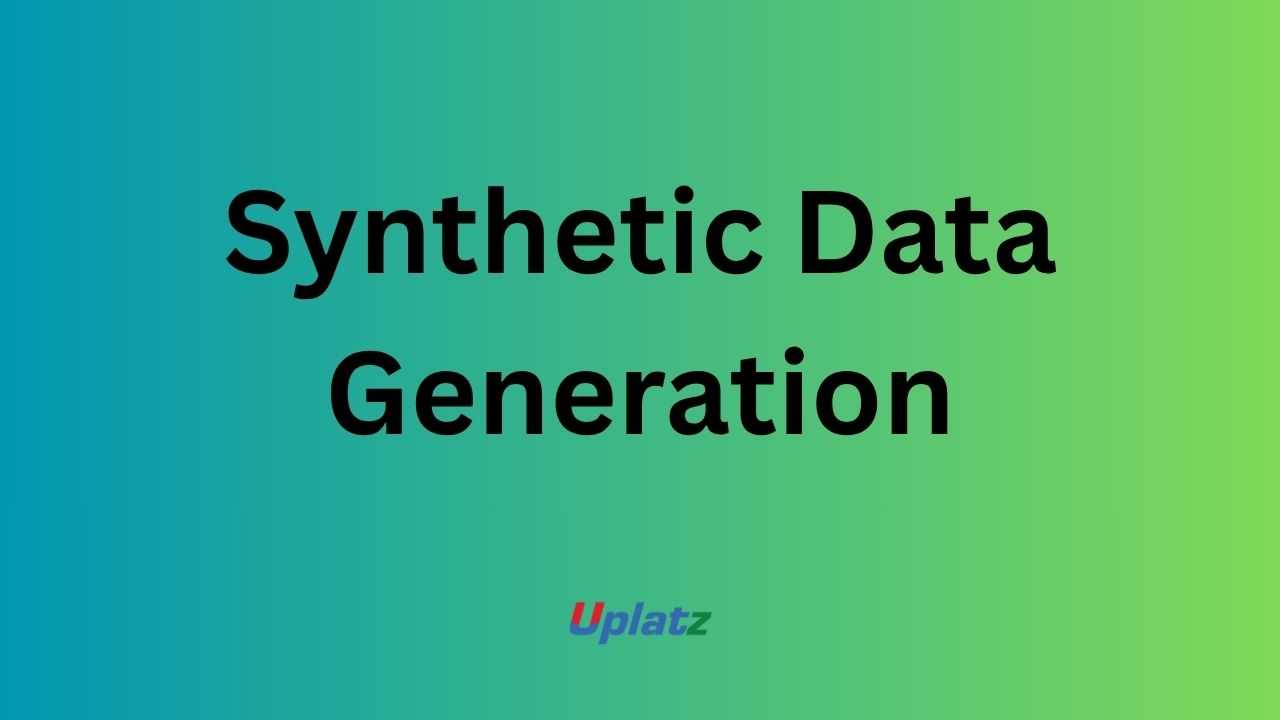Synthetic Data Generation
Create Artificial Yet Realistic Data to Train Robust and Privacy-Safe AI Models Price Match Guarantee
Full Lifetime Access
Access on any Device
Technical Support
Secure Checkout
Course Completion Certificate
Price Match Guarantee
Full Lifetime Access
Access on any Device
Technical Support
Secure Checkout
Course Completion Certificate
 97% Started a new career
BUY THIS COURSE (
97% Started a new career
BUY THIS COURSE (GBP 12 GBP 29 )-
 86% Got a pay increase and promotion
86% Got a pay increase and promotion
Students also bought -
-

- Federated Learning
- 10 Hours
- GBP 12
- 10 Learners
-

- Green AI: Sustainable & Efficient AI Development
- 10 Hours
- GBP 12
- 10 Learners
-

- AI Cybersecurity
- 10 Hours
- GBP 12
- 10 Learners

Data has become the fuel that powers modern artificial intelligence — but real-world data is often limited, expensive, sensitive, or difficult to collect. As organisations increasingly face challenges around privacy, compliance, data scarcity, and imbalance, the need for high-quality alternative data has never been greater. Synthetic data generation has emerged as one of the most powerful innovations in AI, enabling the creation of realistic, statistically accurate datasets without exposing confidential information.
The Synthetic Data Generation course by Uplatz provides a complete and practical introduction to the principles, algorithms, and real-world applications of artificially generated data. You’ll understand how cutting-edge generative models — including GANs, VAEs, and Diffusion Models — simulate complex behaviours, replicate real data distributions, and help organisations accelerate AI development without risking privacy. Whether you’re working in machine learning, analytics, or innovation-driven industries, this course equips you with the skills to generate safe, scalable, and high-utility synthetic datasets.
🔍 What Is Synthetic Data?
Synthetic data is artificially generated information that preserves the structure, distribution, and relationships found in real-world datasets — but does not reveal any identifiable or sensitive data about individuals. Instead of collecting or sharing raw data (which may violate privacy or compliance rules), organizations can use synthetic data that is:
-
Realistic
-
Privacy-safe
-
Highly scalable
-
Statistically consistent
-
Customisable
This makes synthetic data ideal for training and testing machine-learning systems, validating analytics pipelines, and expanding datasets where real observations are rare or imbalanced.
Synthetic data can be generated for:
-
Tabular data (financial, medical, transactional records)
-
Images (faces, medical scans, satellite images)
-
Text (documents, chat logs, summaries)
-
Time-series (sensor data, stock data, IoT streams)
-
Simulations & agent-based environments
The course explains how synthetic data transforms AI development while reducing reliance on sensitive or hard-to-access real datasets.
⚙️ How Synthetic Data Generation Works
Synthetic data can be produced using three main approaches:
1. Statistical & Rule-Based Simulation
Uses mathematical models, probability distributions, or domain rules to generate data resembling the real patterns.
2. Generative AI (GANs, VAEs, Diffusion Models)
Modern Deep Learning methods enable high-fidelity synthetic data creation:
-
GANs (Generative Adversarial Networks) generate realistic samples by pitting a generator against a discriminator.
-
VAEs (Variational Autoencoders) produce smooth, structured latent representations of data.
-
Diffusion Models generate highly detailed and noise-free images, audio, and text sequences.
3. Agent-Based Modelling & Physics Simulation
Useful for robotics, autonomous vehicles, and behavioural modelling.
Agents interact in a virtual environment to simulate realistic actions.
Additional key concepts covered in the course include:
-
Data augmentation
-
Fairness & bias mitigation
-
Distribution modelling
-
Correlation preservation
-
Utility vs. privacy trade-offs
You’ll learn how each technique works and how to choose the right method for different data-driven applications.
🏭 Industry Applications of Synthetic Data
Synthetic data is now widely adopted by companies such as Google, Nvidia, Meta, OpenAI, Tesla, Microsoft, JP Morgan, Roche, and Siemens. It supports industries where real data is sensitive, scarce, or expensive to collect.
Key applications include:
1. Healthcare
-
Medical imaging augmentation
-
Privacy-preserving patient data
-
Multi-hospital model development without data sharing
2. Finance
-
Fraud detection modelling
-
Synthetic transaction data
-
Compliance-friendly analytics
3. Autonomous Vehicles & Robotics
-
Synthetic sensor data (LiDAR, radar)
-
Simulated driving environments
-
Rare scenario creation for safety testing
4. Cybersecurity
-
Simulated attack data
-
Synthetic malicious traffic
-
Zero-day event modelling
5. Customer Intelligence
-
Generating realistic customer records
-
Testing product features with simulated behaviour
6. Manufacturing & IoT
-
Digital twins and synthetic sensor streams
-
Predictive maintenance workflows
Synthetic data is rapidly becoming an essential asset for AI innovation across both research and industry.
🌟 Benefits of Learning Synthetic Data Generation
Mastering synthetic data offers multiple advantages:
-
Stronger Privacy Protection
Build datasets without exposing sensitive or regulated information. -
Solve Data Scarcity & Imbalance
Generate unlimited data for rare classes or under-represented groups. -
Accelerate AI Model Development
Train models faster with larger and more diverse datasets. -
Improve Model Accuracy & Generalisation
Realistic synthetic samples reduce overfitting and improve robustness. -
Enable Cross-Industry Collaboration
Share synthetic datasets without legal restrictions or privacy concerns. -
High Demand in Emerging AI Roles
Companies now actively seek professionals skilled in synthetic data workflows. -
Hands-On Experience with Generative Models
Gain practical exposure to GANs, VAEs, Diffusion Models, and simulation tools.
📘 What You’ll Learn in This Course
This course offers an end-to-end exploration of synthetic data technologies, including:
-
Types of data, statistical relationships, and bias structures
-
Statistical and rule-based data simulation
-
Building text, image, audio, and tabular synthetic datasets
-
GANs, VAEs, and Diffusion Models
-
Agent-based simulations for robotics and autonomous driving
-
Data augmentation strategies
-
Evaluating synthetic data quality: privacy, utility, and fidelity metrics
-
Using Python, NumPy, PyTorch, Scikit-learn, and synthesis libraries
-
Case studies in healthcare, finance, IoT, and cybersecurity
-
Capstone project: full synthetic data pipeline for a real-world ML model
🧠 How to Use This Course Effectively
To maximize learning:
-
Start with data fundamentals — types, distributions, correlations, and biases.
-
Build statistical and rule-based synthetic datasets.
-
Progress to deep generative models like GANs and VAEs.
-
Experiment with generating synthetic images, text, and tabular data.
-
Test synthetic data in real ML tasks such as classification and anomaly detection.
-
Evaluate your synthetic dataset using quality and utility metrics.
-
Complete the capstone project to create a full production-ready synthetic data pipeline.
Hands-on coding and experimentation will help reinforce concepts throughout the course.
👩💻 Who Should Take This Course
This course is ideal for:
-
Data Scientists
-
Machine Learning Engineers
-
AI Researchers
-
Data Analysts
-
Privacy Engineers & Security Professionals
-
Autonomous Systems Engineers
-
Healthcare Informatics Specialists
-
Students entering AI and generative modeling
Basic Python knowledge is recommended.
🚀 Final Takeaway
Synthetic data is transforming how AI is built — enabling innovation while protecting privacy and overcoming data limitations. The Synthetic Data Generation course by Uplatz gives you the knowledge and practical skills to design, generate, and validate high-quality synthetic datasets for real-world applications.
By the end of this course, you’ll be ready to create synthetic data pipelines that drive accuracy, safety, and scalability across AI-powered organisations.
-
Understand the concept and need for synthetic data.
-
Learn the differences between real, augmented, and simulated data.
-
Implement rule-based and AI-based data generation techniques.
-
Build and train GANs, VAEs, and Diffusion Models.
-
Generate synthetic text, tabular, and image data.
-
Apply synthetic data for data augmentation and model generalisation.
-
Ensure privacy and bias mitigation in synthetic datasets.
-
Evaluate data realism and statistical accuracy.
-
Integrate synthetic data pipelines into ML workflows.
-
Prepare for roles in data engineering and AI innovation.
Course Syllabus
Module 1: Introduction to Synthetic Data and Its Applications
Module 2: Statistical Modelling and Data Simulation
Module 3: Generative Models – GANs, VAEs, and Diffusion Networks
Module 4: Data Augmentation and Transformation Techniques
Module 5: Synthetic Text, Image, and Tabular Data Generation
Module 6: Privacy Preservation and Bias Reduction
Module 7: Tools and Frameworks – SynthCity, Gretel, SDV, and Faker
Module 8: Evaluation Metrics for Synthetic Data Utility
Module 9: Industry Case Studies – Healthcare, Finance, and Robotics
Module 10: Capstone Project – Build a Synthetic Data Generation Pipeline
Upon successful completion, learners receive a Certificate of Completion from Uplatz, confirming their expertise in Synthetic Data Generation. This Uplatz certification validates your ability to design, build, and evaluate synthetic data solutions that enhance AI performance while ensuring privacy and fairness.
The certification aligns with global trends in AI ethics, data governance, and responsible innovation. It is ideal for data scientists, ML engineers, and compliance professionals seeking to overcome real-world data challenges using synthetic approaches.
Earning this certification demonstrates your readiness to work on advanced AI projects that require secure, scalable, and high-quality synthetic datasets.
With industries prioritising data privacy and compliance, Synthetic Data Engineers are becoming highly sought-after professionals. Completing this course from Uplatz prepares you for positions such as:
-
Synthetic Data Scientist
-
Data Simulation Engineer
-
Privacy-Preserving AI Specialist
-
AI Research Scientist
-
Data Quality Engineer
Professionals in this domain typically earn between $105,000 and $185,000 per year, depending on their industry and level of expertise.
Career opportunities are expanding in healthcare, autonomous systems, financial technology, and cybersecurity — sectors where generating high-fidelity data without privacy compromise is essential. This course empowers you to create trustworthy datasets that accelerate innovation across the AI ecosystem.
-
What is synthetic data?
Artificially generated data that replicates the statistical properties of real-world data. -
Why is synthetic data important?
It enables model training without privacy violations or reliance on scarce data. -
How is synthetic data generated?
Using statistical simulation, generative AI (GANs, VAEs), or rule-based synthesis. -
What are GANs?
Generative Adversarial Networks — AI models with generator and discriminator components that create realistic synthetic data. -
How does synthetic data improve privacy?
It removes personal identifiers and replaces sensitive records with generated equivalents. -
What are common use cases?
Healthcare research, fraud detection, autonomous vehicles, and finance. -
How do you evaluate synthetic data quality?
By comparing statistical similarity and model performance on real vs synthetic datasets. -
What tools are popular for synthetic data generation?
SDV, Gretel, SynthCity, and Microsoft Presidio. -
What are potential drawbacks?
Over-fitting to training data, loss of diversity, and reduced utility if poorly generated. -
How is synthetic data used in deep learning?
To augment datasets, balance classes, and improve model generalisation.









